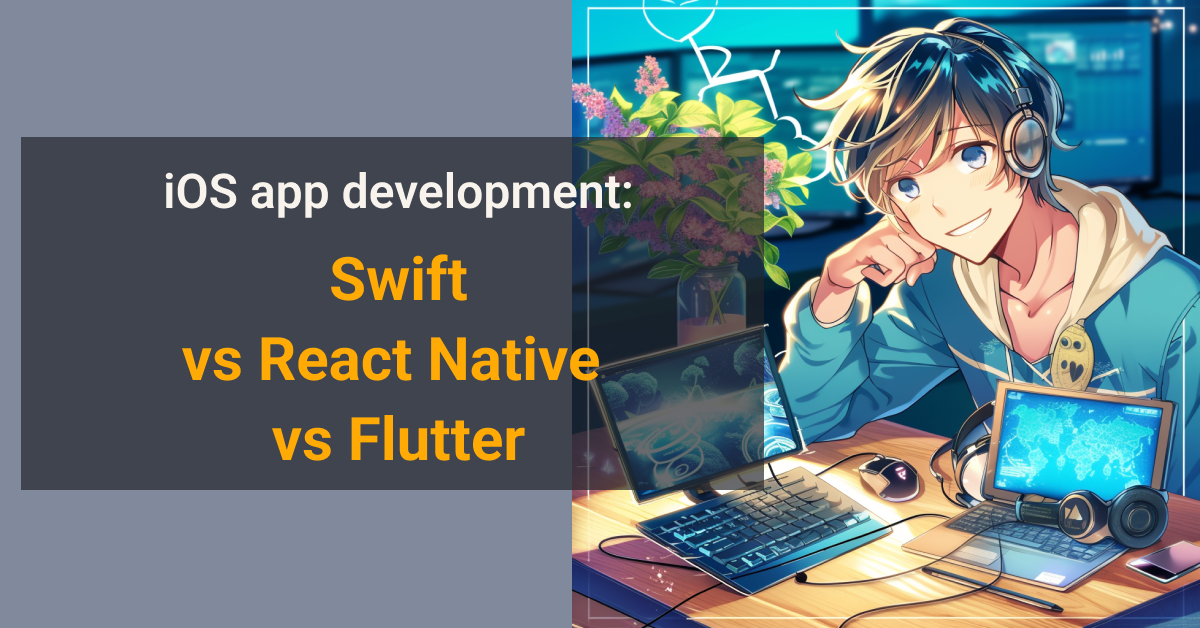
Introduction: Choosing the Right Framework for Your iOS App
The world of iOS app development presents a crucial question for developers and businesses alike: Which framework offers the best pathway to success? In “iOS app development: Swift vs. React Native vs. Flutter,” we delve into this pivotal decision, comparing three leading technologies in the app development arena.
Each framework – Swift, React Native, and Flutter – brings its unique strengths and considerations to the table. Swift, with its deep integration into the Apple ecosystem, offers unmatched performance for native iOS apps. React Native blurs the lines between web and mobile, providing a versatile solution for cross-platform development. Meanwhile, Flutter emerges as a strong contender with its expressive UI capabilities and efficient codebase sharing across platforms.
This article aims to guide you through the intricacies of these frameworks, shedding light on their performance, development efficiency, and ecosystem support. With Pryvus Studio’s expertise, we offer insights to help you make an informed decision that aligns with your iOS app development goals.
Swift: The Powerhouse of Native iOS Development
Swift stands at the forefront of native iOS development, offering a fast, efficient, and safe pathway to build iOS apps. Launched by Apple in 2014, Swift has rapidly become the go-to language for developers looking to leverage the full potential of iOS hardware and software capabilities. But what sets Swift apart in the crowded field of app development?

“Swift combines modern language features with robust performance to deliver superior iOS apps.”
Here’s why Swift shines in native iOS development:
- Performance: Swift’s optimization for iOS ensures apps run smoothly and efficiently, enhancing user experience and engagement.
- Safety: Designed with safety in mind, Swift minimizes common programming errors, making apps more stable and secure.
- Modern Syntax: Swift’s clean and concise syntax makes code easier to read and write, speeding up the development process without compromising on functionality or quality.
- Interoperability with Objective-C: Swift works seamlessly alongside Objective-C, allowing developers to integrate new features into existing apps without a complete overhaul.
- Support from Apple: As Apple’s preferred programming language for iOS, Swift benefits from comprehensive documentation, frequent updates, and a strong developer community.
For businesses and developers aiming for top-notch iOS apps that fully exploit the platform’s capabilities, Swift offers a compelling, future-proof choice. Its emphasis on performance, safety, and developer productivity makes it a cornerstone of native iOS app development.
React Native: Bridging the Gap Between Web and Mobile
React Native has revolutionized the way developers approach iOS app development. By enabling the use of JavaScript and React, it offers a seamless bridge between web and mobile app development, allowing for the creation of native-like apps across both iOS and Android platforms from a single codebase. What makes React Native a game-changer for iOS development?

“React Native democratizes app development, combining the efficiency of web development with the performance of native platforms.”
The standout features of React Native for iOS include:
- Cross-Platform Development: Write once, run anywhere—React Native reduces development time and cost by utilizing a single codebase for both iOS and Android.
- Native Performance: Despite being a cross-platform framework, React Native apps can achieve near-native performance through the use of native components.
- Hot Reloading: The hot reloading feature enhances developer productivity by allowing instant feedback on code changes, without the need for full rebuilds.
- Vibrant Community: A strong and active developer community supports React Native, providing a wealth of libraries, tools, and resources.
- Flexibility: React Native is compatible with third-party plugins, offering flexibility in adding functionalities like Google Maps or Facebook login.
React Native is particularly suited for projects where time to market and budget efficiency are priorities, without significantly compromising on the user experience. It’s an ideal choice for businesses looking to develop their iOS app alongside an Android version, ensuring consistency and quality across platforms.
Flutter: The Rising Star of Cross-Platform Development
Flutter has carved out its niche in the cross-platform development space, offering a unique blend of performance and versatility that appeals to a broad spectrum of developers and businesses. With its Dart programming language, Flutter enables the creation of visually stunning, natively compiled applications for iOS, Android, and beyond. What sets Flutter apart, and how does it stack up for iOS app development?

“Flutter’s approach to cross-platform development harmonizes customization with native performance, setting a new standard for app excellence.”
Key advantages of Flutter for iOS include:
- Single Codebase: Like React Native, Flutter allows for writing a single codebase that compiles into native code on both iOS and Android, streamlining the development process.
- Rich UI Capabilities: Flutter’s widget-based architecture enables the creation of custom, expressive UIs that closely mimic native components, enhancing the user experience.
- Performance: Flutter apps run directly on the hardware without the need for a JavaScript bridge, delivering robust performance that rivals native development.
- Hot Reload: This feature significantly speeds up the development cycle, allowing developers to see changes in real-time without restarting the app.
- Growing Ecosystem: Despite being relatively new, Flutter has a rapidly expanding ecosystem with a wealth of packages and tools available to developers.
Flutter is particularly appealing for projects prioritizing distinctive UI/UX designs and those aiming for a consistent brand experience across multiple platforms. Its performance, coupled with the efficiency of a shared codebase, positions Flutter as a compelling option for iOS app development alongside Android.
Performance Comparison: Swift, React Native, and Flutter
Performance is paramount in the user experience of any app, particularly on iOS devices known for their sophisticated user base. Swift, React Native, and Flutter each bring distinct advantages and challenges to the table in this regard. Let’s break down how they compare:

“Choosing the right development framework impacts not just your app’s initial success but its long-term viability.”
Swift is tailored for iOS, offering unmatched performance, especially for complex, high-load applications. Its direct integration with iOS hardware means Swift apps typically exhibit superior speed and efficiency, essential for graphics-intensive applications or those requiring significant data processing.
React Native, while offering a near-native experience, may sometimes lag behind in performance due to its reliance on the JavaScript bridge for communicating with native components. However, for many applications, this difference is negligible and can be mitigated with careful optimization.
Flutter shines with its high-performance rendering engine and ability to compile to native code, which can rival and sometimes even exceed native performance. Its unique approach allows for smooth animations and transitions, making it a strong contender for performance-sensitive applications.
In summary, while Swift provides the best performance for native iOS applications, both React Native and Flutter offer competitive alternatives that can meet or exceed user expectations, depending on the specific requirements of the project.
Development Efficiency and Ecosystem: A Closer Look
The development efficiency and richness of the ecosystem surrounding a programming language or framework can significantly impact the speed, cost, and quality of app development. Swift, React Native, and Flutter each offer unique ecosystems and tools that cater to different development needs and priorities.

“The right ecosystem not only streamlines development but also enriches the app’s functionality and user experience.”
Swift benefits from Apple’s extensive support, with comprehensive documentation, a wide range of developer tools, and a strong community. The integration with Apple’s ecosystem, including Xcode and SwiftUI, enhances development efficiency, especially for developers deeply embedded in Apple’s environment.
React Native offers the advantage of JavaScript’s ubiquity, with a vast community and a plethora of libraries and tools that facilitate rapid development and easy integration of web-based services. Its cross-platform nature allows for shared knowledge and components across iOS and Android, potentially reducing development time and costs.
Flutter has quickly built a robust ecosystem with its own set of widgets and tools, supported by Google and an enthusiastic community of developers. Its comprehensive framework provides everything needed for app development, from the UI components to testing tools, making it a self-sufficient choice for developers looking for speed and consistency across platforms.
Choosing between Swift, React Native, and Flutter depends on your project’s specific requirements, your team’s expertise, and your long-term development strategy. Each option offers distinct advantages in terms of development efficiency, community support, and the richness of their ecosystems.
Success Stories: Diverse Paths to App Excellence
Choosing the optimal development framework is crucial for project success. Pryvus Studio’s extensive experience with Swift, React Native, and Flutter has enabled us to guide our clients to make informed decisions, leading to several standout projects. Here are highlights from our portfolio:

“Strategic technology choices pave the way for transformative app projects.”
A luxury retail brand approached us with the goal of creating an engaging, immersive shopping experience on iOS. Leveraging Swift, we developed an app that not only offered seamless performance but also integrated advanced AR features, resulting in increased customer engagement and sales.
In another project, a cross-functional team aimed to launch a productivity tool simultaneously on iOS and Android. Using React Native, we delivered a unified app experience that boosted productivity for its users, showcasing the efficiency and consistency achievable with cross-platform development.
For a startup focused on fitness, creating a visually rich and interactive app was paramount. With Flutter, we built a cross-platform app that delivered a captivating user experience with smooth animations and responsive design, demonstrating Flutter’s capability to produce apps with a competitive edge in user experience.
These examples underscore the importance of aligning technology choices with project goals and requirements. At Pryvus Studio, we specialize in understanding these nuances, ensuring that each app we develop not only meets but exceeds our clients’ expectations.
Conclusion: Making the Informed Choice for iOS Development
The landscape of iOS app development is rich with possibilities, each offering its own set of advantages and challenges. Whether you choose Swift for its native prowess, React Native for its cross-platform efficiency, or Flutter for its expressive UI capabilities, the key lies in aligning your choice with your project’s specific needs and objectives.
At Pryvus Studio, we understand the nuances of these technologies and how they can be best leveraged to bring your vision to life. Our success stories are a testament to our ability to navigate the complexities of app development, ensuring that our clients not only launch successful apps but also create experiences that resonate with their users.
Embarking on your iOS app development journey requires a partner who not only understands the technical landscape but also aligns with your vision for success. Let Pryvus Studio be that partner, guiding you through the decision-making process and beyond, towards achieving your digital aspirations.


